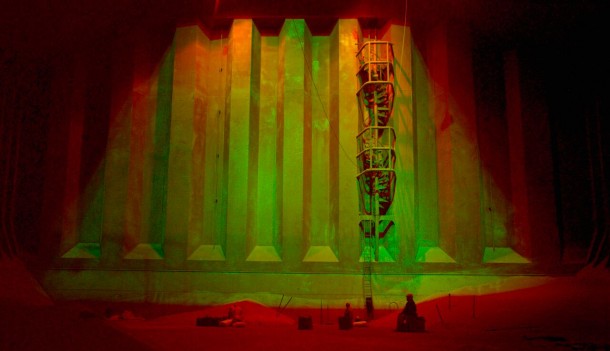
Director: Mauro Herce
Writers: Mauro Herce, Manuel Muñoz Rivas
Spain/France | Documentary | 70 min
Mauro Herce’s invigoratingly nightmarish DEAD SLOW AHEAD is the masterclass in sound design that your ears never knew they needed. At 70 minutes, Herce’s feature-length debut is a lushly disquieting documentary about life at sea—though the creaks, groans and sighs of the freighter on which it was filmed are prioritised, for the most part, over the humans that inhabit and maintain it. This highly impressive, wholly immersive Spanish-French co-production won the Special Ciné+ Jury Prize upon bowing at Locarno this year, and won Best World Documentary at Jihlava Documentary Film Festival, prior to screening in both the ‘New Waves’ strand and the characteristically strong ‘Resistencias’ competition at the 12th Seville European Film Festival.
DEAD SLOW AHEAD takes place on the Fair Lady, an enormous cargo ship on the high seas of the Mediterranean. Its crewmembers—so closing credits tell us—hail from Odessa, Nicolaev, Istanbul, Port Said, Ismailia, Suez, Aqaba, Cueta, Triumph and New Orleans. That’s just about all the information we’re able to glean about their backgrounds, however, for Herce focuses more—at least for the spellbinding first half-hour—on the sound textures and rhythms at work within this languorous steel kraken, illuminating the musicality of its throbbing, horror-like pulse. (The important credits here are Daniel Fernández, sound; Alejandro Castillo and Manuel Muñoz Rivas, sound design; Carlos E. Garcia, mix; and José Manuel Berenguer, music.) Sonar beeps sound off like a track from experimental electronic band Autechre, while internal rumbles and churning whirs play out like an ancient whale’s prolonged, mournful cries. Is this an Ark for a post-industrial age, drifting across the earth’s seas in search of an ungodly land flooded long ago? Or is it the first ship to chart a new and wondrous planet?
It comes as something of a relief when Herce first cuts away from the close confines of the ship itself to a panorama of daytime mist. As if compelled by some dormant force beyond the thick fog, however, tunefully ominous sounds begin to crescendo in again: a wall of wind, industrial howls, and expressive, non-diegetic wails. In this vast, open eternity, the Fair Lady provides shelter to men from horizon-dwelling storms. The ship is a hermetically sealed universe affording its own sonic logic, with something as otherwise mundane as a ringing telephone elevated to a screech of dreadful import. “Attention, please,” says one crewmember into the receiver. “There’s water coming into the ship. An entire river is entering through the keel. That’s a lot.”
Herce would do well not to draw too much attention to the viscous velocity of his film. The Fair Lady might have actually made a better, less obvious title—for the ship is the one immovable constant in a film that otherwise makes a point of dramatic fluctuations. The same previously mentioned scene, for instance, in which a sailor reports an emergency, is shot from a fixed frame, so that while the mise-en-scène looks dead-still like a photograph, the actual backdrop—the horizon—bobs in and out of view through the windows that look from the ship’s bridge into infinity. When water begins to leak into the ship, there’s nothing the ship itself can do, as is again made evident by a tripod-fixed shot, taken from the bridge looking over the hull. It emphasises the vessel’s rigidity as it’s tossed around with hammy, old-age grandiosity by the playfully ruthless sea.
It’s perhaps unfortunate timing that DEAD SLOW AHEAD should arrive so soon after LEVIATHAN (2012), by Lucien Castaing-Taylor and Verena Paravel, or even after CRUDE OIL (2008), Wang Bing’s fourteen-hour epic about life on a remote Chinese oil field. But Herce’s is a more stylised film than Wang’s, and unlike LEVIATHAN, it’s less concerned with the processes of human labour than the vessel’s actual architecture: at one point we see the ship’s blueprints, while at others the colour palette boasts the kind of orange-green contrasts only ever seen in heavy industrial milieu (Herce graduated in engineering and fine arts before enrolling at film schools in Cuba and Paris).
Just as the Fair Lady seems disproportionately immobile, incapable and insignificant compared to the ocean that surrounds it, so the sound and ferocity of its own machinery overwhelm the fragile, human frames within it. During one scene in which we see the seamen enjoying downtime by participating in a bout of karaoke, Herce has the images of such revelry accompanied by a non-diegetic soundscape completely at odds in tone and timbre. Late in the film, we hear the men make calls home to wish loved ones a happy new year—but the images we see are mechanical pans through the ship’s deepest bowels and impossibly smooth tilts up through its pipework. The natural speed of the human conversations we hear couldn’t further contradict the supernatural slowness of the non-human mechanisms by which Herce observes his way through this geometric environment—before settling, in the film’s one explicitly derivative moment, on a ventilation duct, like that haunting penultimate sequence of Apichatpong’s SYNDROMES AND A CENTURY (2006).
DEAD SLOW AHEAD also recalls Allan Sekula and Noel Bürch’s THE FORGOTTEN SPACE (2010), an essay film about the freighting trade and its relationship to transglobal capitalism. But whereas that film was an eminently intellectual exercise, Herce’s debut is a decidedly—and, it must be said, profitably—aesthetic affair. Not that the two have to be separate, of course, but this film’s philosophical currents emerge not so much through speculative rumination (no voice-over, scant dialogue) as through its commitment to conspicuously cinematic mood-setting—and, yes, storytelling. MICHAEL PATTISON
DEAD SLOW AHEAD IS SCREENING AT SEVILLE FILM FESTIVAL 6-14 NOVEMBER 2015 | WINNER OF THE SPECIAL JURY PRIZE – FILMMAKERS OF THE PRESENT | LOCARNO 2015